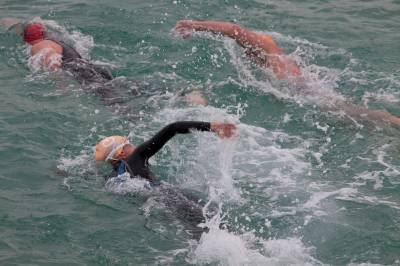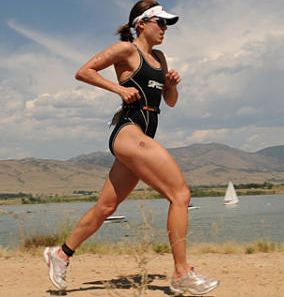Triathletes are Exploding! And so are their Injuries- What to look out for.
Sunday, December 7, 2014

They're logging their laps in the pool, time on the bike and trial times too - and then injury hits them right off to the sideline.
Overuse or overtraining accounts for the majority of injuries triathletes endure. And they're more likely to get hurt running than swimming. To avoid becoming injured or be proactive in dealing with injuries, we take a look at 5 most common triathlon injures and how to prevent or treat them.
Shoulder Pain - Rotator Cuff Injury or Bursitis
If you're experiencing dull aches or sharp pains in your shoulder, you may have torn your rotator cuff. Especially if you notice it when you lift your arm above your head when swimming.
Freestyle swimming strokes tend to develop the muscles around the chest and front of the shoulder. This means your shoulders can become more rounded - something that creates an imbalance with the rest of your shoulder and neck muscles.
It's a good idea to slow down the minute you start feeling any pain. Rest the area, stretch the chest, neck and thoracic spine and back off the high intensity stuff. See your physio for a specific regime and treatment.
You may eventually benefit from specific exercises- either with resistance bands or weights to build shoulder strength and bring balance to the shoulders and avoid injury.

Iliotibial Band Syndrome
The symptoms of IT band syndrome include tightness or pain on the outside of the knee, just behind your joint. This area is the key stabiliser for the leg so when it acts up, it can debilitate bikers and runners.
The IT band starts in the glutes and hips and travels down the outside of the thigh. It becomes aggravated when you up your mileage too rapidly and start repeatedly bending and straightening the knee, causing friction and leading to flare ups. But you can use foam rollers to break down knots and help the muscles repair.
This is often an overuse or biomechanics issue- so you may benefit from seeing your physio to have your running technique assessed.
Check out our blog on ITB Syndrome for more info.
Achilles Tendonitis
You're experiencing Achilles tendonitis if you feel pain above your heel and below your calf. You may even notice swelling in the area or feel a creaking in your tendon. This happens when the calf muscles tighten up and pull on the tendons, causing tiny tears in your Achilles.
There are a few things you can try for this- use a foam roller to release your calf, hamstring and shins. Roll your foot over a spikey ball to break down knots. Try an ice pack for 20mins if there are signs of swelling and see your physio for some dry needling.

Patellar Tendonitis
Symptoms of patellar tendonitis include pain in the centre of the knee, just under the kneecap. You'll feel it if you sit for extended periods, like when you're biking, and also when walking up and down stairs.
This injury is caused when the quads or other surrounding structures become inflamed or tight and pull the kneecap against your joint. The culprit for triathletes is usually improper bike set up. So do schedule a proper bike fitting and use a foam roller to loosen up the quadriceps and ITB.
Stress Fractures
Triathletes mainly experience stress fractures in the foot, hip and tibia. You'll feel a pain in the bone when you're working out and there's likely to be a little swelling.
Stress fractures happen when you increase your training volume dramatically with allowing the body to properly adapt and recover. If you do suspect you have a stress fracture, stop running and go for an X-ray. You'll need to rest for around 6 to 8 weeks to let the fracture heal. But you can still swim!
To avoid getting stress fractures, start off by being clever with your mileage when you run, especially if you're a newbie. Be sure to take rest days all through your training. You could even opt to do about 40 percent of your training on a treadmill or surface other than concrete or tar to take the pounding off the legs.
Final Word
Triathletes, whether new or dab-hands, need to go about their training carefully and cleverly to avoid these common injuries. If you experience an injury, be sure to attend to it quickly and once recovered, continue to work on strengthening the affected area.
